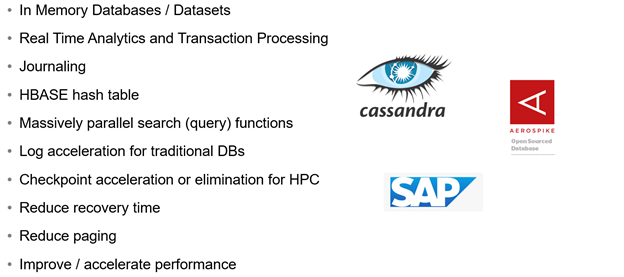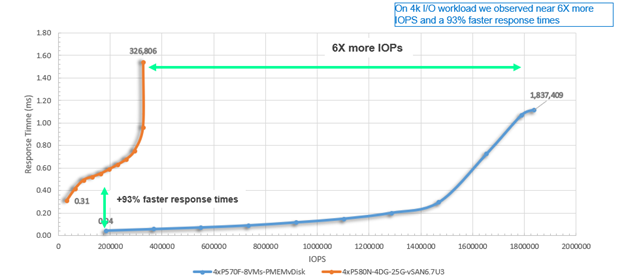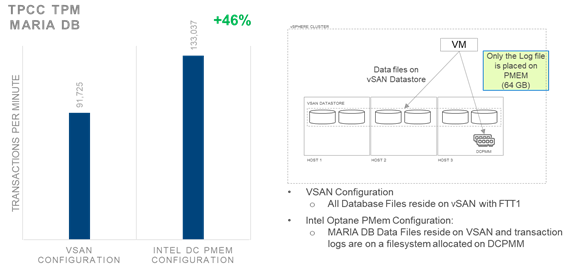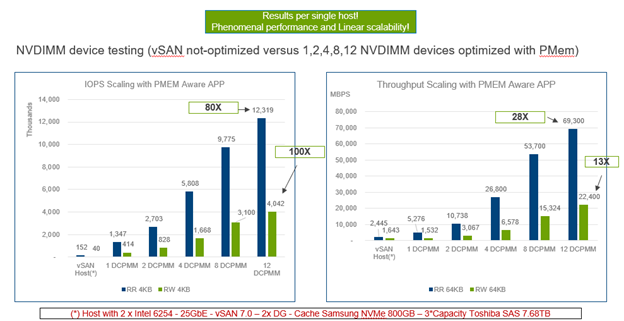

VxRail drives the hyperconverged evolution with the release of 4.7.410
Wed, 24 Apr 2024 13:35:32 -0000
|Read Time: 0 minutes
VxRail announces new hardware and software in this latest release
January 6, 2020
VxRail recently released a new version of our software, 4.7.410, which we announced at VMworld EMEA in November. This release brings cutting-edge enhancements for networking options and edge deployments, support for the Mellanox 100GbE PCIe NIC, and two new drive types.
Improvements and newly developed functionality for VxRail 2-node implementations provide a more user-friendly experience. Now supporting both direct connect and new switched connectivity options. VxRail 2-node is increasingly popular for edge deployments, and Dell EMC continues to bolster features and functionality in support of our edge and 2-node customer base.
This release also includes improvements for VxRail networking capabilities that more closely align VxRail with VMware’s best practices for NIC port maximums and network teaming policies. VxRail networking enhancements more efficiently handle network traffic due to support for two additional load balancing policies. These new policies determine how to route network traffic in the event of bottlenecks, and the result is better/increased throughput on a NIC port. In addition, VxRail now supports the same three routing/teaming policies as VMware.
Dell EMC also announced support for Fiber channel HBAs in mid-summer of 2019, and with that, the 4.7.410 release has broadened capabilities by supporting external storage integration. VxRail recognizes that an external array is connected and makes it available to the vCenter for use as secondary storage. The storage is now automatically recognized during day 1 installation operations, or on day 2, when external storage is added to expand the storage capacity for VxRail.
In addition to the 4.7.410 release, VxRail added a new set of hardware choices and options to include the Mellanox ConnectX-5 100GBe NIC cards benefitting a variety of use cases including media broadcasting, a larger 8TB 2.5” 7200 rpm HDD commonly used for video surveillance, and a 7.6TB “Value SAS SSD”. Value SAS drives offer attractive pricing (similar to SATA) with performance slightly below other SAS drives and are great for larger read-friendly workloads. And finally, there’s big news for the VxRail E series platforms (E560/E560F/E560N) which all support the T4 GPU. This is the first time VxRail is supporting GPU cards outside of the V series. The Nvidia T4 GPU is optimized for high-performance workloads and suitable for running a combination of entry-level machine learning, VDI, and data inferencing.
These exciting new features and enhancements in the 4.7.410 release enable customers to expand the breadth of business workloads across all VxRail implementations.
Please check out these resources for more VxRail information:
VxRail 4.7.x Release Notes (requires log-in)
By: KJ Bedard - VxRail Technical Marketing Engineer
LinkedIn: https://www.linkedin.com/in/kj-bedard-50b25315/
Twitter: @KJbedard
Related Blog Posts

VxRail & Intel Optane for Extreme Performance
Tue, 02 Mar 2021 17:47:20 -0000
|Read Time: 0 minutes
Enabling high performance for HCI workloads is exactly what happens when VxRail is configured with Intel Optane Persistent Memory (PMem). Optane PMem provides compute and storage performance to better serve applications and business-critical workloads. So, what is Intel Optane Persistent Memory? Persistent memory is memory that can be used as storage, providing RAM-like performance, very low latency and high bandwidth. It’s great for applications that require or consume large amounts of memory like SAP HANA, and has many other use cases as shown in Figure 1 and VxRail is certified for SAP HANA as well as Intel Optane PMem.
Moreover, PMem can be used as block storage where data can be written persistently, a great example is for DBMS log files. A key advantage to using this technology is that you can start small with a single PMem card (or module), then scale and grow as needed with the ability to add up to 12 cards. Customers can take advantage of PMem immediately because there’s no need to make major hardware or configuration changes, nor budget for a large capital expenditure.
There are a wide variety of use cases today including those you see here:

Figure 1: Intel Optane PMem Use Cases
PMem offers two very different operating modes, that being Memory and App Direct, and in turn App Direct can be used in two very different ways.
First, Intel Optane PMem in Memory mode is not yet supported by VxRail. This mode acts as volatile system memory and provides significantly lower cost per GB then traditional DRAM DIMMs. A follow-on update to this blog will describe this mode and test results in much more detail once it is supported.
As for App Direct mode (supported today), PMem is consumed by virtual machines as either a block storage device, known as vPMemDisk, or as byte addressable memory, known as Virtual NVDIMM. Both provide great benefit to the applications running in a virtual machine, just in very different ways. vPMemDisk can be used by any virtual machine hardware, and by any Guest OS. Since it’s presented as a block device it will be treated like any other virtual disk. Applications and/or data can then be placed on this virtual disk. The second consumption method, NVDIMM has the advantage of being addressed in the same way as regular RAM, however, it can retain its data through reboots or power failures. This is a considerable plus for large in-memory databases like SAP HANA where cache warm-up or the time to load tables in memory can be significant!
However, it’s important to note that, like any other memory module, the PMem module does not provide data redundancy. This may not be an issue for some data files on commonly used applications that can be re-created in case of a host failure. But a key principle when using PMem, either as block storage or byte addressable memory is that the applications are responsible for handling data replication to provide durability.
New data redundancy options are expected on applications that are using PMem and should be well understood before deployment.
First, we’ll look at test results using PMem as virtual disk (or vPMemDisk). Our Engineering team tested VxRail with PMem in App Direct mode and ran comparison tests against a VxRail all-flash (P570F series platform). The testing simulated a typical 4K OLTP workload with 70/30 RW ratio. Our results achieve more than 1.8M IOPs or 6X more than the all-flash VxRail system. That equates to 93% faster response times (or lower latency) and 6X greater throughput as shown here:

Figure 2: VxRail PMem App Direct versus VxRail all-flash
This latency difference indicates the potential to improve the performance of legacy applications by placing specific data files on a PMem module, for example, placing log files on PMem. To verify the benefit of this log acceleration use case we ran a TPC-C benchmark comparing VxRail configured with a log file on a vPMEMDIsk to a VxRail all-flash vSAN, and we saw a 46% improvement on the number of transactions per minute.
 Figure 3: Log file acceleration use case
Figure 3: Log file acceleration use case
For the second consumption method, we tested PMem in App direct mode using the NVDIMM consumption method. We performed tests using 1,2,4,8 and then 12 PMEM modules. All testing has been evaluated and validated by ESG (Enterprise Strategy Group). The certified white paper has been published as highlighted in the resources section.

Figure 4: NVDIMM device testing (vSAN not-optimized versus optimized PMem NVDIMM)
The results prove linear scalability as we increase the number of modules from 1 to 12. And with 12 PMem modules, VxRail achieves 80 times more IOPs than when running against vSAN not optimized (meaning VxRail all-flash vSAN with no PMem involved), and 100X for the 4K RW workload. The right half of the graphic depicts throughput results for very large IO, 64KB. When PMem is optimized on 12 modules we saw 28X higher throughput for a 64KB random read (RR) workload, and PMem is 13 times faster for the 64K RW.
What you see here is amazing performance on a single VxRail host and almost linear scalability when adding PMem!! Yes, that warrants a double bang. If you were to max out a 64-node cluster, the potential scalability is phenomenal and game changing!
So, what does all this mean? Key takeaways are:
- The local performance of VxRail with Intel Optane PMem can scale to 12M read IOPS, and more than 4M write IOPs or 70GB/s read throughput / 22GB/s write throughput on a single host.
- The use of PMEM modules doesn’t affect the regular activity on vSAN Datastores and extends the value of your VxRail platform in many ways;
- It can be used to accelerate legacy applications, such as RDBMS Log acceleration
- It enables the deployment of in memory databases and applications that can benefit from the higher IO throughput provided by PMEM while still taking the benefit of vSAN characteristics in the VxRail platform
- The local performance of a single host with 12 x 128GB PMem modules achieves more than 12M read IOPS, and more than 4M write IOPs
- It not only increases performance of traditional HCI workloads such as VDI, but also support performance-intensive transactional and analytics workloads
- It offers orders-of-magnitude faster performance than traditional storage
- It provides more memory for less cost as PMem is much less costly than DRAM
The references and validation testing have been completed by ESG (Enterprise Strategy Group). White papers and other resources on VxRail for Extreme Performance are available via the links listed below.
Additional Resources
ESG Validation: Dell EMC VxRail and Intel Optane Persistent Memory
VxRail and Intel Optane for Extreme Performance – Engineering presentation
Dell EMC & Intel Optane Persistent Memory - video
ESG Validation: Dell EMC VxRail with Intel Xeon Scalable Processors and Intel Optane SSDs
By: KJ Bedard – VxRail Technical Marketing Engineer
LinkedIn: https://www.linkedin.com/in/kj-bedard-50b25315/
Twitter: @KJbedard

VxRail brings key features with the release of 4.7.510
Mon, 17 Aug 2020 18:31:30 -0000
|Read Time: 0 minutes
VxRail recently released a new version of our software, 4.7.510, which brings key feature functionality and product offerings
At a high level, this release further solidifies VxRail’s synchronous release commitment with vSphere of 30 days or less. VxRail and the 4.7.510 release integrates and aligns with VMware by including the vSphere 6.7U3 patch release. More importantly, vSphere 6.7U3 provides the underlying support for Intel Optane persistent memory (or PMem), also offered in this release.
Intel Optane persistent memory is non-volatile storage medium with RAM-like performance characteristics. Intel Optane PMem in a hyperconverged VxRail environment accelerates IT transformation with faster analytics (think in-memory DBMS), and cloud services.
Intel Optane PMem (in App Direct mode) provides added memory options for the E560/F/N and P570/F and is supported on version 4.7.410. Additionally, PMem will be supported on the P580N beginning with version 4.7.510 on July 14.
This technology is ideal for many use cases including in-memory databases and block storage devices, and it’s flexible and scalable allowing you to start small with a single PMem module (card) and scale as needed. Other use cases include real-time analytics and transaction processing, journaling, massive parallel query functions, checkpoint acceleration, recovery time reduction, paging reduction and overall application performance improvements.
New functionality enables customers to schedule and run "on demand” health checks in advance, and in lieu of the LCM upgrade. Not only does this give customers the flexibility to pro-actively troubleshoot issues, but it ensures that clusters are in a ready state for the next upgrade or patch. This is extremely valuable for customers that have stringent upgrade schedules, as they can rest assured that clusters will seamlessly upgrade within a specified window. Of course, running health checks on a regular basis provides sanity in knowing that your clusters are always ready for unscheduled patches and security updates.
Finally, the VxRail 4.7.510 release introduces optimized security functionality with two-factor authentication (or 2FA) with SecurID for VxRail. 2FA allows users to login to VxRail via the vCenter plugin when the vCenter is configured for RSA 2FA. Prior to this version, the user would be required to enter username and password. The RSA authentication manager automatically verifies multiple prerequisites and system components to identify and authenticate users. This new functionality saves time by alleviating the username/password entry process for VxRail access. Two-factor authentication methods are often required by government agencies or large enterprises. VxRail has already incorporated enhanced security offerings including security hardening, VxRail ACLs and RBAC, KMIP compliant key management, secure logging, and DARE, and now with the release of 4.7.510, the inclusion of 2FA further distinguishes VxRail as a market leader.
Please check out these resources for more VxRail 4.7.510 information:
By: KJ Bedard - VxRail Technical Marketing Engineer
LinkedIn: https://www.linkedin.com/in/kj-bedard-50b25315/
Twitter: @KJbedard


